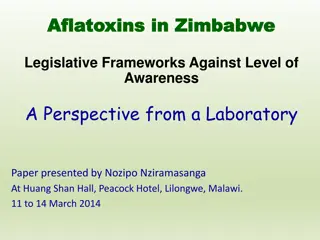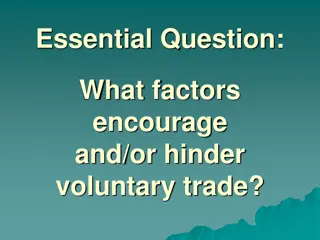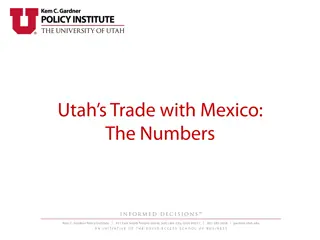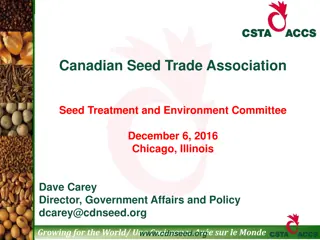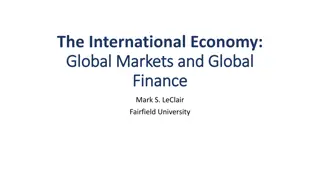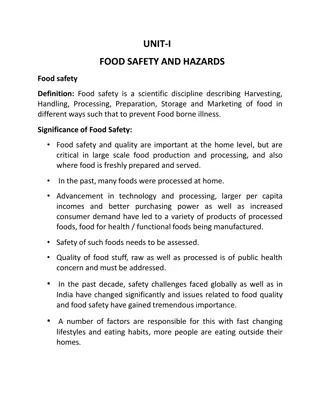Understanding Global Trade Impacts on Food Safety and Regulations
Exploring the complexities of global food trade, this material delves into how foodborne pathogens and other risks affect trade, the role of standards and regulations in restoring trust in food systems, challenges with increasing food trade, and current standards and regulations to mitigate food risks. It also highlights the FDA Food Safety Modernization Act as a significant step in enhancing food safety measures in the United States.
Download Presentation

Please find below an Image/Link to download the presentation.
The content on the website is provided AS IS for your information and personal use only. It may not be sold, licensed, or shared on other websites without obtaining consent from the author. Download presentation by click this link. If you encounter any issues during the download, it is possible that the publisher has removed the file from their server.
E N D
Presentation Transcript
COMPLIMENTARY TEACHING MATERIALS MICROBIAL FOOD SAFETY A FOOD SYSTEMS APPROACH Charlene Wolf-Hall and William Nganje
Chapter 14: Impacts on Global Trade and Regulations COMPLIMENTARY TEACHING MATERIALS
Key Questions How do foodborne pathogens and other agents impact trade? How do nations use standards and regulations to restore trust in our food supply system? What are the similarities and differences among measures to restore trust in our global food supply? COMPLIMENTARY TEACHING MATERIALS
Global Trade Impacts of Foodborne Pathogens Consumer demand escalates food trade and requires delivering more tonnage through ports of entry (POE), rail, trucks, and air. Increased volumes of food trade with ever increasing velocity have been associated with significant food safety risks (unintentional food contamination from pathogens, chemical, or physical agents) and food defense risks (intentional food contamination by disgruntled employees or terrorists). COMPLIMENTARY TEACHING MATERIALS
Challenges with Increasing Food Trade Food trade is increasing around the globe due to a growing middle class and several other factors. For demand more fresh produce and food throughout the year, in particular during non-productive U.S. seasons. example, American consumers continually Increased volumes of imported foods with ever increasing velocity have been associated with significant food safety and food defense risks. COMPLIMENTARY TEACHING MATERIALS
Current Standards and Regulations Mitigating the impacts of food risks on trade involves private- public partnership. Countries develop policies and private sector develop certifications and standards to mitigate trade impacts from food risks and restore consumer confidence on safe trade flows. COMPLIMENTARY TEACHING MATERIALS
On December 21, 2010, the US Congress passed the FDA Food Safety Modernization Act, the first major food safety measure in the United States in more than 60 years. The measure will require importers to be responsible for making sure the food they bring into the country meets US safety standards. COMPLIMENTARY TEACHING MATERIALS
Technology at ports of entry used could include: X-ray and gamma-imaging systems. Customs Border Protection (CBP) officers analyze these images to determine anomalies associated with the cargo listed on the manifest. Automated targeting system (ATS). ATS is a mathematical model that uses weighted rules that assign a risk score to each arriving shipment in a container, based on manifest information. USDA-APHIS initiates inspections of imported produce at the farms in Mexico or their packing and processing facilities with a 24-hour e-manifest rule (US Department of Homeland Security, 2003). Customs and Border Protection (CBP). Uses intelligence and risk based strategies to screen information on 100% of the cargo before it is loaded onto vessels bound for US. COMPLIMENTARY TEACHING MATERIALS
Layered Defense 1. Screening and inspection: CBP screens 100% of all cargo before it arrives in the US using intelligence and cutting edge technologies. 2. 24-Hour rule: Manifest information must be provided 24 hours prior to the sea container being loaded onto the vessel in the foreign port. 3. C-TPAT/FAST: CBP and the companies work together to baseline security standards for supply chain and container security. COMPLIMENTARY TEACHING MATERIALS
4. Free and Secure Trade (FAST) Program seeks to expedite the clearance of trans-border shipments by reducing customs information requirements, dedicating lanes at major crossings to FAST participants, using common technology, and physically examining low risk shipments with minimal frequency. 5. CAVER plus Shock is a risk assessment survey instrument used to assess risks and vulnerabilities to food risks. (http://www.fda.gov/downloads/Food/FoodDefense/FoodDefe nsePrograms/UCM376929.pdf) COMPLIMENTARY TEACHING MATERIALS
Comparing Three Measures to Restore Trust in Global Food Supply Trade Some attributes of California leafy green standard The California Leafy Green Products Handler Marketing Agreement (LGMA) was created in 2007 by Californian farmers. It included 14 leafy green products associated with the LGMA program (arugula, baby leaf lettuce, butter lettuce, cabbage, chard, endive, escarole, green leaf lettuce, iceberg lettuce, kale, red leaf lettuce, romaine lettuce, spinach, and spring mix). COMPLIMENTARY TEACHING MATERIALS
The LGMA food safety best practices cover five key areas: 1. General requirements; 2. Environmental assessments; 3. Water use; 4. Soil amendments; 5. Work practices and field observations. COMPLIMENTARY TEACHING MATERIALS
Some attributes of the US FDA Guide to Minimize Microbial Food Safety Hazards The FDA s guide was created in 1998 in response to increased outbreaks of foodborne illness (FDA, 1998). The purpose is to provide the industry with guidelines to minimize microbial food safety hazards for fresh produce during all stages of the farm-to-table food chain, including: 1. Growers; 2. Farm workers; 3. Packers; 4. Shippers; 5. Transporters; 6. Importers; 7. Wholesalers; 8. Retailers; 9. Government agencies; 10. Consumers. COMPLIMENTARY TEACHING MATERIALS
USDA: Mitigating the risk of microbial contamination includes five major areas: 1. Water quality; 2. Manure/municipal bio-solids; 3. Worker hygiene; 4. Field, facility, and transport sanitation; 5. Traceability. COMPLIMENTARY TEACHING MATERIALS
Some attributes GLOBALGAP GLOBALGAP acknowledges consumer concerns on food safety, animal welfare, environmental protection, and worker welfare. GLOBALGAP is a single integrated standard with modular applications for crops (fruit and vegetables, flowers and ornamentals, combinable crops, coffee, tea, cotton, etc.), livestock (cattle, sheep, dairy, pigs, poultry, etc.), and aquaculture (salmon, trout, shrimp, tilapia, etc). COMPLIMENTARY TEACHING MATERIALS
GLOBALGAP: areas of focus include: 1. Traceability and record keeping; 2. Record keeping and internal/self-inspection; 3. Varieties and rootstock; 4. Site history management, soil and substrate management; 5. Fertilizer use and irrigation; 6. Crop protection and harvesting; 7. Produce handling; 8. Waste/pollution management, recycling and re-use; 9. Worker health, safety and welfare, and complaint forms. COMPLIMENTARY TEACHING MATERIALS
Similarities among Standards and Policies Traceability: All three programs require a product traceability system. Quality of irrigation water: The standards and processes to ensure irrigation water quality is adequate for intended use: records of irrigation water usage, banning the use of untreated sewage water for irrigation, reviewing existing practices, and performing microbial tests. Hygiene: Processes and personnel are covered by the three programs. Pest management: It is mandatory that producers adhere to laws and regulations in regards to pest control. COMPLIMENTARY TEACHING MATERIALS
Overlaps among Programs LGMA vs. USDA 1. LGMA and USDA focus on the appropriate storage of organic fertilizers. 2. LGMA and the USDA acknowledge the use of soil amendments that contain animal manure that are physically heat treated or processed by other equivalent methods. 3. Natural fertilizers, such as composted manure. 4. Fertilizers containing natural components. 5. Non-synthetic crop treatment. COMPLIMENTARY TEACHING MATERIALS
All three programs The three guidelines require that field equipment, such as harvesting machinery, knives, containers, tables, baskets, packaging materials, brushes, buckets, are properly used and sanitized before using. Growers are expected to ensure produce that is washed, cooled, or packaged in the field is not contaminated in the process. COMPLIMENTARY TEACHING MATERIALS
Differences among Programs Comprehensive evaluation of programs: 1. LGMA has the most comprehensive best business practices associated with the farm operations (Climate Conditions and Environment, Soil Amendments, Environmental Assessment, Water Usage and Flooding). 2. USDA Guidance for Industry has the most comprehensive guidelines for the transportation of produce to the final destination. 3. GLOBALGAP has the most comprehensive audit process in regards to produce packaging and storage. COMPLIMENTARY TEACHING MATERIALS
Summary With increasing international trade in the marketing system and limited resources to inspect and test all products for pathogens, these pathogens could spread fairly rapidly across our borders causing significant economic loss. However, public private partnership with regulation (USDA) and standards (LGMA and GLOBALGAP) create mechanisms to restore trust in food trade across the globe. COMPLIMENTARY TEACHING MATERIALS
THANK YOU Name: Charlene Wolf-Hall & William Nganje Email: charlene.hall@ndsu.edu & William.Nganje@ndsu.edu COMPLIMENTARY TEACHING MATERIALS





